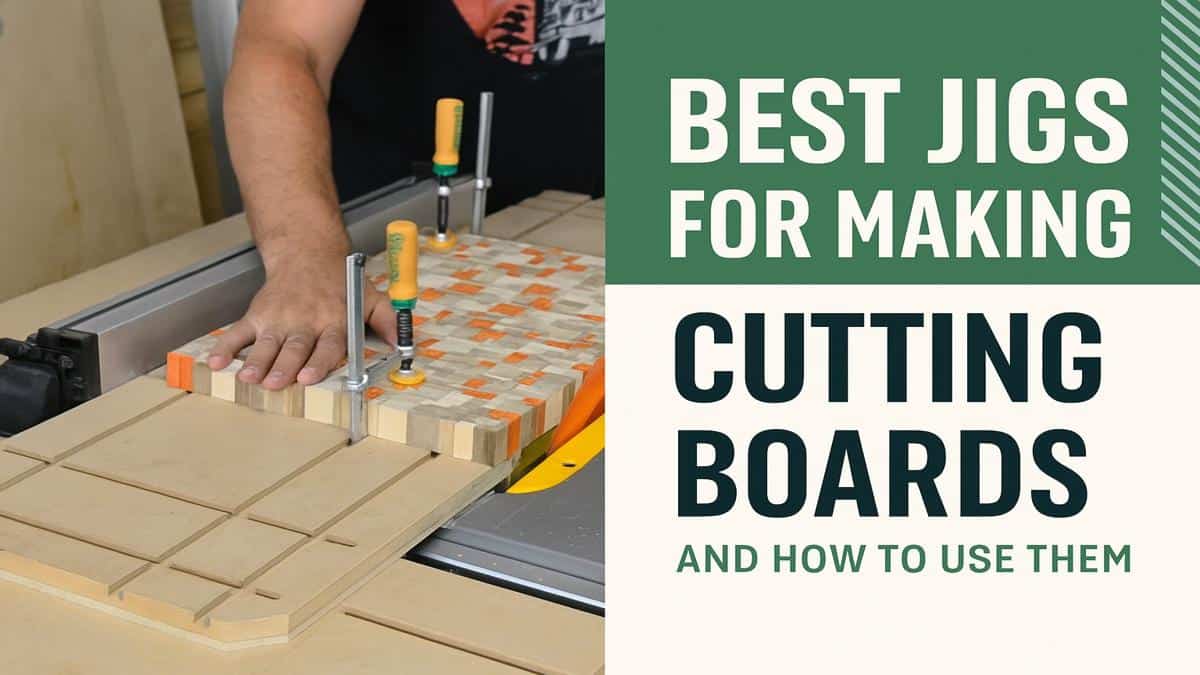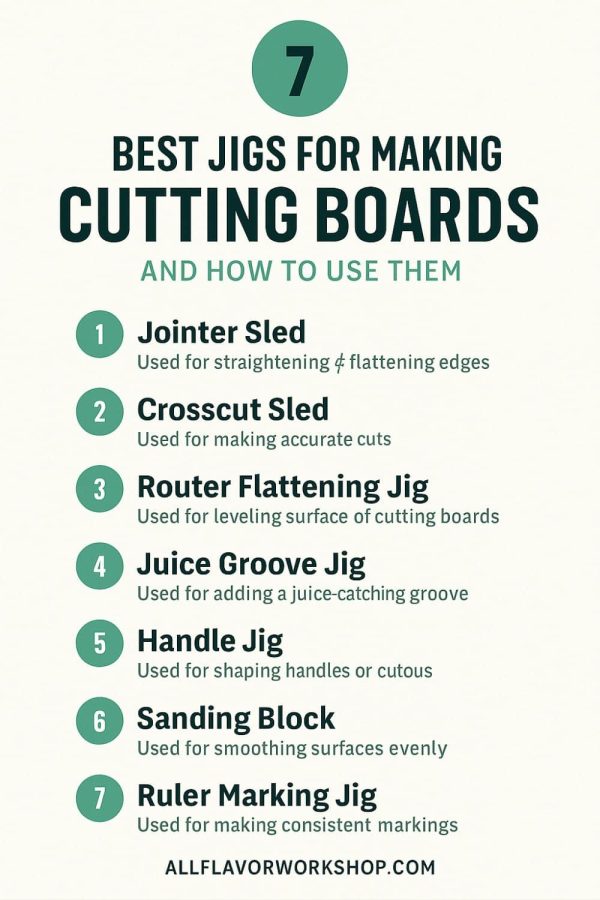Cutting boards are one of the best woodworking projects to build—whether you’re just getting started or looking to practice more advanced techniques. From edge grain to end grain designs, the overall process may differ, but the core set of jigs I use stays the same.
These jigs help with everything from jointing edges and flattening the surface to routing juice grooves and handles. Some of them are essential to getting clean, accurate results—others are optional, but once you try them, you’ll wonder how you ever worked without them.
Over time, I’ve built and refined a handful of jigs that now live in my shop full-time. Each one has its purpose—and together, they make cutting board builds smoother, faster, and a lot more enjoyable.
In this post, I’ll walk you through the jigs I use most when making cutting boards—how they work, what they help with, and how you can build your own.
Table of Contents
- What Makes These Jigs Perfect for Cutting Boards?
- Jointer Sled
- Crosscut Sled for Table Saw
- Router Flattening Jig
- Juice Groove Jig
- Handle Jig
- Sanding Block
- Ruler Marking Jig
- Comparison Table: Cutting Board Jigs at a Glance
- Final Thoughts
- Frequently Asked Questions (FAQ)
1. What Makes These Jigs Perfect for Cutting Boards?
Making a great cutting board is all about precision, consistency, and a clean finish. And while you could technically build one without any jigs, it gets a whole lot easier—and faster—when you have the right ones in place.
The jigs in this guide are designed to solve the most common issues that come up during cutting board builds:
Crooked or uneven edges? A jointer sled fixes that.
Warped glue-ups? A flattening sled makes things level again.
Uneven juice grooves or handles? These are hard to get right without templates.
Tons of repeated boards to make? Jigs help you keep everything consistent.
Some of the jigs I’m sharing here are absolutely essential—especially the first four. The others aren’t strictly necessary, but they’ll make the entire process smoother and your results more professional. And once you build them, you’ll end up using them on a lot more than just cutting boards.
If you’re planning to make more than one board, these jigs will save you serious time, effort, and mistakes.
2. Jointer Sled
A jointer sled is one of the first jigs I reach for when building a cutting board—especially when starting with rough or uneven stock. This sled helps you straighten edges, square up boards, and remove twists or bows before you move on to cutting and gluing.
The nice thing is that this same jig can double as a tapering jig when needed. That makes it incredibly versatile—not just for cutting boards but for furniture parts, table legs, or any long angled cuts.
Why It’s Useful
- Straightens warped or uneven edges
- Preps boards for glue-ups (especially edge grain)
- Can be adapted to cut tapers if designed with adjustability
- Works even if you don’t have a jointer machine
My Setup
My jointer sled runs along the table saw fence and holds the board firmly in place using toggle clamps. Once the first edge is straight, I trim the other side using a crosscut sled or rip fence. The result: dead-straight boards ready for glue-up.
I use this jig on nearly every cutting board I build. If the edges aren’t square, nothing lines up—and this solves that right from the start.
Related:
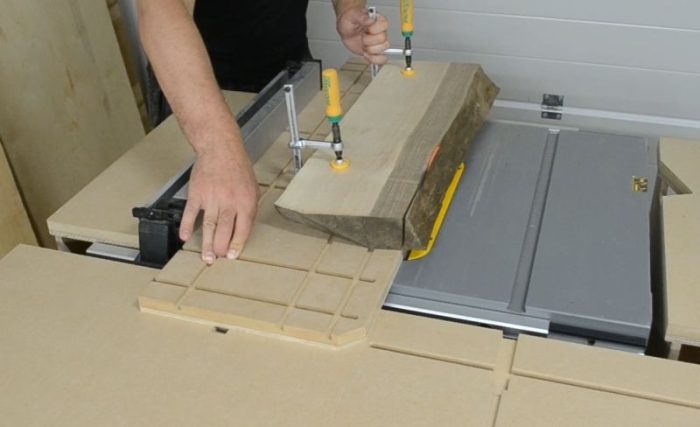
3. Crosscut Sled for Table Saw
This is one of the most-used jigs in my workshop—especially when building cutting boards. Once the boards are jointed, the crosscut sled is what I use to cut the strips to size, and after the glue-up, to trim the ends square, size the final piece, or clean up edges after flattening.
A simple sled with a solid fence and runners makes it easy to get repeatable 90° cuts with much more control and accuracy than the miter gauge alone.
Why it’s useful
- Cuts the wooden strips to size
- Squares up cutting boards after glue-up
- Ensures accurate, repeatable 90° cuts
- Safer and more stable than freehand or using the miter gauge
- Great for sizing edge grain and end grain boards
My setup
I built my sled to fit the table saw’s miter slots, with a solid rear fence and a wide platform for support. I also added stop blocks to make repeated sizing a breeze. It’s one of those jigs that’s always out and always in use—especially when batch-making boards.
It might seem like a basic sled, but once you’ve got one dialed in, it’ll save you so much time—and your boards will always come out clean and square.
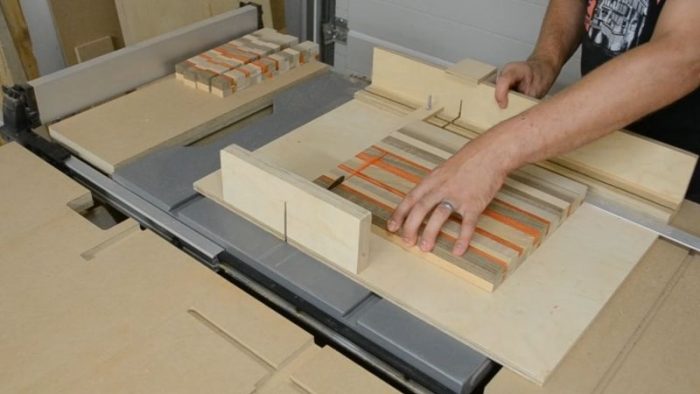
4. Router Flattening Jig
When you’re building cutting boards—especially end grain boards or thicker glue-ups—flattening the surface can be tricky without a planer or drum sander (even with a planer I prefer to use the flattening jig when surfacing end grain boards). That’s where a router flattening jig comes in.
This jig lets you level out warped, uneven, or slightly twisted boards with precision. It’s especially useful after glue-ups when the surface isn’t perfectly flat, or if your boards moved during clamping.
Why it’s useful
- Flattens rough boards for jointing
- Flattens cutting boards after glue-up
- Ideal for leveling large or irregular pieces
- Doesn’t require a planer or expensive equipment
- Can be scaled for different board sizes
My setup
My flattening jig uses aluminum side rails with a sliding router carriage that travels back and forth. I use a wide flattening bit and make overlapping passes. Once you get the rhythm down, the surface comes out perfectly level and ready for sanding.
This jig made a huge difference in the quality of my cutting boards. Before building it, I spent hours sanding down warps and ridges—now I just route it flat and move on.
Related:
🔗 How to Build a DIY Router Flattening Jig
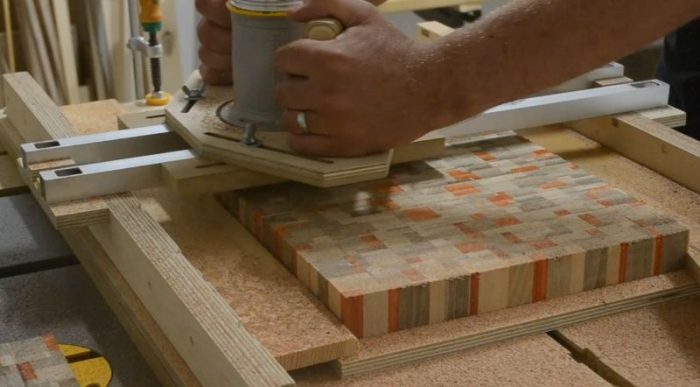
5. Juice Groove Jig
If you want your cutting boards to look polished and professional, adding a juice groove is a great finishing touch—especially on boards meant for carving or prepping juicy foods. But cutting a clean, even groove around the edge of a board is nearly impossible without a jig.
This simple router jig ensures repeatable, centered, and smooth juice grooves every time—no wandering lines, no overcuts (it still needs a bit of experience though ;).
Why it’s useful
- Adds a functional and aesthetic detail
- Keeps your router path controlled and consistent
- Works on rectangular boards of different sizes
My setup
I built a simple base with t-tracks that allows for adjusting the guiding fences as needed. They clamp around the cutting board and act as guides for the router base. You can set your offsets with spacers and just follow the inside edge with a router bit. It’s fast, clean, and super satisfying to use.
Before building this jig, I only used a fence screwed to the table—it worked, but definitely not as easy as a full adjustable groove jig.
Related:
🔗 DIY Juice Groove Jig for Router
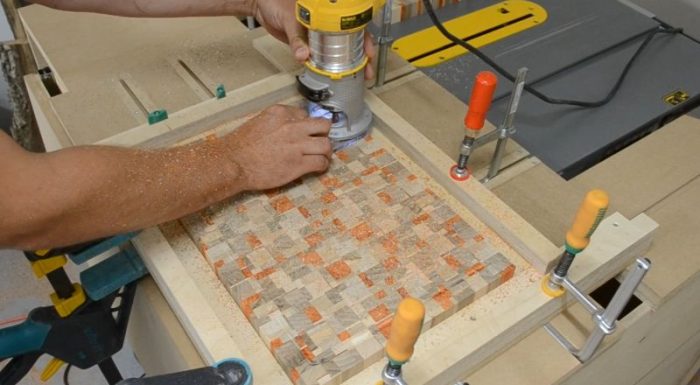
6. Handle Jig (Router Handle Template)
Adding a handle to your cutting board makes it easier to pick up, or move—and a handle jig lets you do it neatly and consistently. This one is especially made for routing finger grips.
It’s a small detail that really improves the usability of the board—and gives it a professional, finished look.
Why it’s useful
- Let’s you easily pick up and move the cutting board
- Ensures all handles are the same size and position
- Works with a handheld router
My setup
I use a handle jig with a U-shaped cutout, centered and clamped onto the board. With a trim router, I route the shape in a few passes.
I’ve reused this jig on dozens of cutting boards—it’s fast, clean, and makes every handle look like it came from a factory.
Related:
🔗 DIY Router Handle Jig – How to Add Handles to a Cutting Board
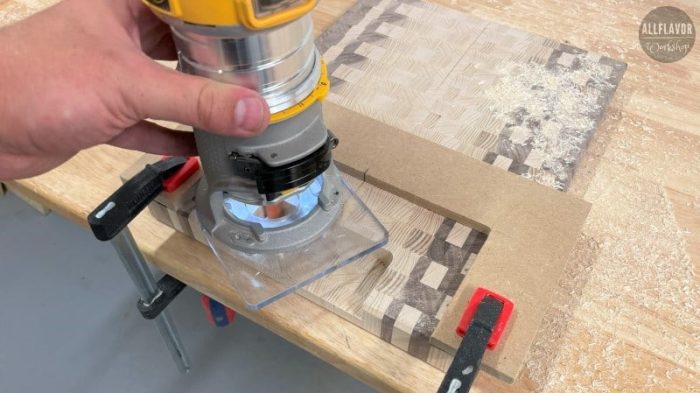
7. Sanding Block
Once the board is cut, flattened, and shaped, you still need to sand it smooth—and sanding by hand can lead to uneven spots or rounded edges where you don’t want them. Yes, ideally, you can use an orbital sander, but if you don’t have one, a sanding block will do just fine. It helps keep things flat and controlled, especially when you want a crisp, professional surface.
Why it’s useful
- Maintains flat surfaces during sanding
- Helps you apply even pressure across the board
- Reduces the risk of rounding edges unintentionally
- Works with standard sandpaper sheets (no power needed)
My setup
I built a few different sanding blocks that fit perfectly in my hand. I usually make them from Baltic birch plywood, which helps apply even pressure during sanding. The best part is you can easily switch out different sandpaper grits depending on the stage of your project.
I reach for this block all the time—not just for cutting boards, but for finishing just about any flat surface in the shop.

8. Ruler Marking Jig
When you’re building multiple cutting boards—or just want to mark things faster and more consistently—a simple ruler marking jig saves time and improves accuracy. It’s perfect for layout lines, center marks, hardware placement, or aligning decorative details.
This jig might not touch the wood directly like a router or saw jig, but it plays a critical role in keeping things precise.
Why it’s useful
- Speeds up repeated measurements and layout
- Helps you mark centerlines, handle placements, rubber feet, or groove offsets
- Reduces measuring errors
- Great for production runs or batch building
My setup
I made mine from a strip of softwood (though hardwood would be better) with an embedded steel ruler and a simple marking notch. I use it especially when marking the placement of rubber feet on the bottom of the board—quick, easy, and consistent.
It’s a tiny jig, but I use it all the time. Especially when making batches of boards or lining up elements like rubber feet or handles.
Related:
🔗 DIY Ruler Marking Gauge – Fast, Accurate Layout Lines
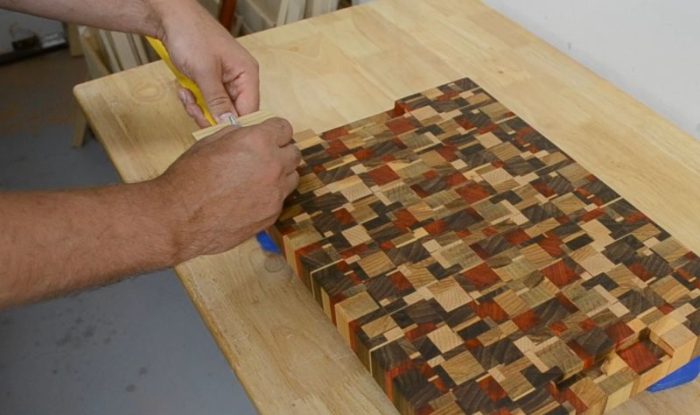
9. Comparison Table: Cutting Board Jigs
Here’s a quick overview of each jig, what it’s used for, and when it comes into play during the cutting board build.
| Jig | Used For | Tool Required | When It’s Used |
|---|---|---|---|
| Jointer Sled | Straightening and squaring edges | Table saw | Before glue-up |
| Crosscut Sled | Squaring ends and sizing boards | Table saw | After glue-up / Final trimming |
| Router Flattening Jig | Flattening uneven board surfaces | Trim or plunge router | After glue-up |
| Juice Groove Jig | Routing consistent juice grooves | Trim or plunge router | Final detailing |
| Handle Jig | Adding routed finger or oval handles | Router | Final detailing |
| Sanding Block | Flat, even sanding without rounding | None (manual) | Final surface finishing |
| Ruler Marking Jig | Fast, accurate layout and measurements | Pencil + ruler | Throughout the build |
10. Final Thoughts
Over the years, I’ve built many cutting boards—plain, edge grain, end grain, and even patterned ones. Boards are a great woodworking project: you can make them simple or complex, customize the look, and put them straight to use in your own kitchen.
My first few boards weren’t perfect. I’ll admit, I was pretty frustrated—especially with my OCD nature of wanting everything perfectly aligned and symmetrical. But that’s exactly where these jigs made the biggest difference. They help reduce errors, increase repeatability, and give you cleaner, more satisfying results—no matter what level you’re at.
The best part? You can make all of them yourself, even in a small workshop. And they’ll continue paying off long after your first project.
💬 My woodworking journey actually started with making jigs. I loved seeing how they worked—and how they made every step easier. Plus, I saved a lot of money by building them instead of buying ready-made versions.
If you’re new to woodworking jigs or want to start with the essentials, check out this guide:
🔗 5 Essential Woodworking Jigs for Beginners (You Can Build Now)
11. Frequently Asked Questions
Do I need special jigs to make a cutting board?
No, but jigs help a lot. While you can technically make a board without them, jigs improve accuracy, save time, and lead to cleaner results—especially if you plan to build more than one.
What jig should I build first for cutting boards?
Start with a jointer sled and a crosscut sled. These two jigs alone will help you square up your stock and size your board properly. From there, add a flattening jig and juice groove jig as needed.
Can I flatten a cutting board without a planer?
Yes! A router flattening sled is a great alternative to a planer or drum sander. It lets you level your board using a trim or plunge router, even if it’s warped or uneven.
How do I cut a juice groove consistently?
The easiest way is with a juice groove jig. It guides your router around the perimeter of the board with consistent spacing and depth, giving you a clean, professional groove every time.
Can I use the same jigs for edge grain and end grain boards?
Yes. The jig setup stays mostly the same whether you’re making edge grain or end grain boards. You’ll just be more careful with flattening and sanding for end grain, which is tougher on tools.

